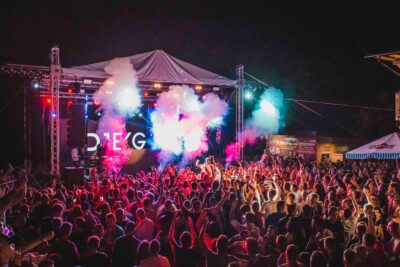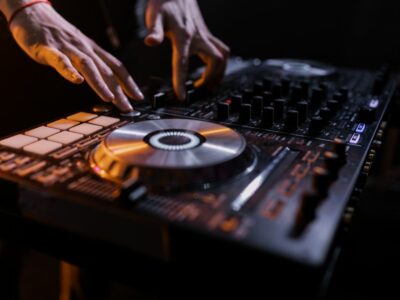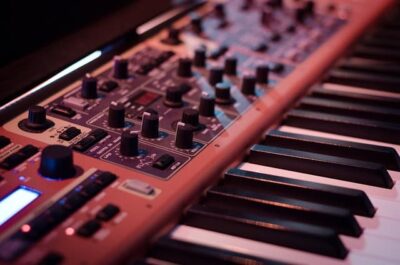20 Major Tracks in the History of Electronic Music
10 min read
A list of 20 major electronic tracks.
Delia Derbyshire “Dr Who Theme” (1963)
The first electronic hit created before the era of industrial synthesizers. The young BBC Radiophonic Workshop employee recorded the title theme for the new series using white noise generators and tone oscillators – instruments designed to check the acoustics of a room, not to create music. What followed were hours of film splicing, speeding up and slowing down loops, overdubs, and other manual work. The result was one of the most recognizable themes in cinema, linking electronic music and science fiction for a long time. Despite the success of the series, the Decca label initially didn’t even want to release it on vinyl, because it sounded too unusual for the standards of the sixties. It was only a year later that “Dr Who Theme” was finally released officially.
Morton Subotnick “Silver Apples of the Moon” (1967)
If Delia Derbyshire showed that it was perfectly possible to create hits with electronic instruments, American composer Morton Subotnick set another basic vector for the electronic music space. The release of the record by the label Nonesuch (where only classical music had been released before) was a kind of recognition of electronics as a high art. And for good reason – with the modular Buchla 100 system (in the creation of which Subotnick himself helped engineer Don Buchla) Morton shows that the synthesizer is not just another instrument in the big family, but an avant-garde tool that allows you to get rid of the intrusive limitations of musical tradition. Without this record, there would be no Glitch, no late Autechre, and no current renaissance of modular synths.
Neu! “Hallogallo” (1972)
Krautrock is a classic example of music ahead of its time. In the seventies, trend-hungry publishers (especially in Britain) tried unsuccessfully to make German rioters into stars, and this music became really appreciated already in the nineties, when books began to be written about Krautrock and its influence was discussed by all kinds of musicians from Radiohead to Seefeel and Mouse on Mars. Düsseldorf’s Neu! founded by Michael Roter and Klaus Dinger after they had left Kraftwerk, seemed to be the main symbol of the Krautrock renaissance. In the nineties they were sampled by Stereolab and System7, and covers were recorded by Download and Autechre. In the noughties Neu! started to be massively re-released, and in the 2010s neo-crout based primarily on the percussion pattern of Klaus Dinger became music, if not mass, then extremely fashionable.
Kraftwerk “Autobahn” (1974)
It’s hard to find an electronic genre in which the Germans Kraftwerk haven’t left a vivid mark. It’s timelessly topical krautrock, majestic space electronics, synth-pop, electro and even techno. The thing that perhaps most unites their talents is the single from the album of the same name, which was a big breakthrough for the band. The band from Dusseldorf, previously known only in a rather narrow krautrock community, suddenly makes a quantum leap into the pop space and breaks through even to the American charts. And if “Autobahn” hadn’t been played on every radio station in the mid-seventies, music history might have been very different.
Tangerine Dream “Rubycon pt 1” (1974)
Edgar Frese and his alternating lineup formation started out with dark, almost noisy music, but discovered sequencers in 1973, and after that the world was no longer the same. The formula “pulsating bass, looped sequences of notes, slightly changing the shape of the sound, and sublime string machines in the background” would define not only space-electronics of all possible waves and generations, but also synth disco – what would Giorgio Moroder, say, do without this stuff? – and then trance. And the title theme from the series “Very Strange Things” is, in fact, an homage to Tangerine Dream.
Donna Summer “I Feel Love” (1977)
We are used to thinking that the future is not made to order, but as if it arises by itself (“the future happens to us while we are busy doing other things,” as Karl Bartos of Kraftwerk sang). In the case of “I Feel Love,” that was not the case. The producer of the track, Giorgio Moroder, was asked by Donna Summer “to make something that would sound like the music of the future”. And the track was meant to be just the cherry on top of a colorful retro album cake, where Donna takes turns trying on musical outfits from different eras. The result is not just one of the biggest disco hits on the planet, but a track without which there would be no club electronica.
Human League “Being Boiled” (1978)
The Sheffield band’s debut single is the perfect balance between somber and cold, but still pop music and experimental, innovative sound design. Soon that balance would collapse, vocalist Phil Oakey would take over, and Human League would become one of Britain’s premier purveyors of dance-pop hits for a long time to come. But their biggest contribution to history is this early piece. Without it there would be no Depeche Mode, no EBM genre, and perhaps even no techno and hip-hop (the single is still often played by Grandmaster Flash in their sets). Well, the formula “the best things happen when a pop singer and an experimentalist take part in a band on equal terms” is still true. But it is still difficult to keep this balance.
Afrika Bambaataa & The Soulsonic Force “Planet Rock” (1982)
A system-forming record for hip-hop and electro grows directly out of Kraftwerk roots. The trio of rappers, producer Arthur Baker, and New York DJ Africa Bambata (one of the godfathers of hip-hop) who led the whole process, decided to recreate on tape what was going on in the streets of the Bronx. The street poets read their rhymes to a mix of electronic records from the late 1970s, so Baker and his comrades used several quotes from Kraftwerk for the instrument. Except that they didn’t sample the broken beat from “Nummern” and the melody from “Trans-Europe Express” (they wouldn’t have enough memory for such tricks anyway), but recreated it from scratch. Fortunately John Roby, the keyboard player, was not only a virtuoso, but also a real synthesizer nerve. The output was a break-dance anthem that influenced everything from the electro genre with its almost forty-year history to Aphex Twin and Herbie Hancock.
New Order “Blue Monday” (1983)
Bernard Sumner and his cohorts were into electronica while still playing in Joy Division, but it wasn’t until they visited New York that they really took to the club rhythms. “The best-selling 12-inch single in history” (a status which, however, can be neither confirmed nor denied for lack of data) not only became the cornerstone of the alternative dance music genre and the foundation of the future unity of rock and rave (the Hacienda club, which became the home of New Order, will become the world center of dance music only in five years), but also the source of many quotations. The keyboard melody from there, for example, will be used in their hits by MIA and Rihanna.
Brian Eno’s “An Ending (Ascent)” (1983)
Eno didn’t so much invent ambient (records falling under this genre tag were released back in the 1960s) as formulate the concept. This turned out to be much more important for creating the scene. And if the record “Ambient 1: Music for Airports” (for which the idea was formulated) sounded more like academic minimalism than electronica, then the track “An Ending (Ascent)” from the album “Apollo: Atmospheres and Soundtracks” is that sublime epic sound, which we associate with the Ino-musician and Ino-producer (listen at least to the beginning of the U2 album “The Joshua Tree”). This piece influenced roughly the entire ambient scene of the nineties, when the genre was recalled by the youth, as well as half a dozen times appeared in movies and TV, from the movies “Drive” and “28 Days Later” to the opening ceremony of the London Olympics and commercials for the British Cancer Research Center.
Phuture “Acid Tracks” (1987)
House emerged in Chicago in the mid-eighties, but it was Herbert Jackson and Earl Smith who made the real breakthrough in the genre. Before “Acid Tracks” came along, house was a kind of “pumped up disco”, after that it became the alien music of the future. The 13-minute psychedelic improvisation was spun by Chicago musicians on literally a couple of instruments in one evening. Before this thing appeared, the Roland TB-303 bass player was a useless piece of metal and plastic (the unit crashed on the market and was sold for next to nothing, so it ended up in the hands of Chicago poor guys), but after it became a cult object.
The Orb “Little Fluffy Clouds” (1991)
This patchwork-like collage based on samples from Steve Reich, Ennio Morricone and Harri Nielson, as well as an interview with singer and actress Ricki Lee Jones (used without permission, of course) is the anthem not only of the ambient house, but of the chillout scene and the whole “sampledelika” in general. It was Alex Patterson who became the hero of those who started going to clubs not only for dancing to frenzy, but also to lie on mattresses, listen to strange music and sometimes move their heads to the beat.
Massive Attack “Unfinished Sympathy” (1991)
To tell the truth, in 1991 there was no feeling at all that thirty years later Massive Attack would grow into one of the most influential bands on the planet. But even at that time there was something absolutely fascinating in the song “Unfinished Sympathy”. The trio of Bristol guys (there were three of them at the time) and the guest singer Shara Nelson showed very convincingly that electronic music is not necessarily “machine music” and fuel for rave euphoria. It’s also about the person, about emotion, about the soul and about sweet sadness. This thing not only paved the way for the whole trip-hop wave, but also laid the foundation for the new soul that took off much later.
The Prodigy “Everybody in the Place (Fairground Mix)” (1992)
The Prodigy is a rare example of a band that achieved mass success not by “standing on the shoulders of giants,” that is, by adapting someone else’s ideas to the needs of a wider audience, but by being true innovators. Liam Howlett and comrades were some of those who were at the origins of British breakbeat, and by trial and error they came up with the formula “torn sampled rhythm, accelerated voices and melodies, which were attached to naivety”. The first version of the track, released a year earlier, turned out to be a false start, but the second, “Fairground Mix,” turned out to be a one hundred percent rave-beat that still lifts the dead on the dance floor. If some aliens come to you and ask you what rave is, play “Everybody in a Place”.
Aphex Twin “On” (1993)
Richard D. James is a rare electronic artist who made history with more than one discovery. He is the coryphaeus of ambient house and the forerunner of deconstructed club, but first of all Richard is the father of a genre with the controversial name IDM (intelligent dance music), the first nerd and subculture music in the electronic continuum, which appeared in the early nineties in the emerging Internet. “On”, which remained a non-album single in the end, probably best embodies the thesis of “struggle of rhythm and melody”, when the transparent and light and naive keyboards are opposed by torn and heavy, generously spiced with overdrive, almost industrial beat. The video for this piece, by the way, was shot by Jarvis Cocker.
Jeff Mills “Bells” (1996)
Everybody knows that techno was born in Detroit, but not everybody knows, that up to the time it sounded quite different. Techno in its current form – fast, hard and repetitive music designed strictly for clubs, was formed in the first half of the 1990s, when techno clubs took root in Europe, especially in Berlin. And perhaps the most striking thing in the modern techno canon was created by a man who unites two worlds – a native of Detroit, who managed not only to become a radio legend under the name of The Wizard (that is, “The Wizard”) and to play in the Underground Resistance group, but also to be a resident of the famous Berlin club Tresor.
Daft Punk “Da Funk” (1997)
Tom Bangalter and Guy-Manuel de Omem-Cristo were among the first to realize that the future of modern electronics is to be a melting pot in which all of humanity’s musical heritage is brewed. Disco groove, techno beats, quavering overloaded rock riffs, funky keyboards, and later soul vocals, vocoders, teary-eyed slow tunes and bombastic art-rock arrangements – all are nothing more than the cubes the French put together the tower of modern sound.
System F “Out of the Blue” (1998)
It so happens that the most influential track is not the one that lays the foundation of the genre and sets the direction of the movement, but the one that sort of sums it up. By 1998, trance seemed to be on its way out of the fair. The Frankfurt wave of the first half of the 1990s had died off, the Goan psychedelic underground had separated, Robert Miles had conquered the charts, and British progressive had taken off. Ferry Corsten came to make trance the domain of the masses, the music of the stadiums. The track, which many people remember from the movie “Breakaway”, paved the way for Tiesto and Armin van Buuren, and, it seems, the crazy success of Avicii with David Guetta and Calvin Harris would not have happened without it.
Benny Benassi “Satisfaction” (2003)
This track, along with the slightly lesser-known Alter Ego track “Rocker”, in fact, set the dance mainstream matrix of the early 21st century – EDM, dubstep and even hip-hop were created after these models. Absolute minimalism in the arrangements, catchy hook (and not even melodic, but vocal), and most importantly – the most powerful, wall-spreading bass line.
Burial “Archangel” (2007)
The loner musician from south London, who avoided publicity (they saw Four Tet and Robert Del Nye from Massive Attack behind Burial, but in the end they agreed that William Bevan is a real person) is the main star of the bass scene, the main achievement of electronica of the noughties. He is also the first voice of music with the prefix “post” and the herald of a new musical philosophy. Technically his sad and sometimes even gloomy-mystical music is based on British rave (he has referred to himself many times as an heir to the “hardcore continuum”), but, in his own words, if the Nineties were a time of euphoria, today we all drive a night bus and suffer heavy withdrawals. Well, you can’t argue with that.




